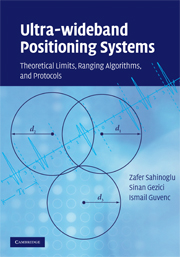Book contents
- Frontmatter
- Contents
- Preface
- 1 Introduction
- 2 Ultra-wideband signals
- 3 Ultra-wideband channel models
- 4 Position estimation techniques
- 5 Time-based ranging via UWB radios
- 6 Ranging protocols
- 7 Special topics in ranging
- 8 Practical considerations for UWB system design
- 9 Recent developments and future research directions
- References
- Index
6 - Ranging protocols
Published online by Cambridge University Press: 23 December 2009
- Frontmatter
- Contents
- Preface
- 1 Introduction
- 2 Ultra-wideband signals
- 3 Ultra-wideband channel models
- 4 Position estimation techniques
- 5 Time-based ranging via UWB radios
- 6 Ranging protocols
- 7 Special topics in ranging
- 8 Practical considerations for UWB system design
- 9 Recent developments and future research directions
- References
- Index
Summary
The previous chapter deals with detecting time of arrival of first signal path. Even though it is an essential and the very first step in TOA-based ranging and positioning systems, more need to be done to obtain range and position estimates. The TOA information makes sense only if the signal's time of transmission is known. Then, time of flight (TOF) of the signal can be easily computed. The TOF is directly proportional to the distance between a device that transmits the signal and the device that receives it. There are various protocols to transform any TOA information to a TOF and range estimate. Ranging protocols require actions to be taken at devices that are involved in ranging and positioning. The focus of this chapter is to study these protocols in detail.
The chapter consists of three parts. The first part provides an overview of communication protocol layers and explains functionalities of the service and management interfaces between adjacent layers. It is important to know what intra- and inter-device events take place for obtaining ranging information and how ranging-related information is passed from the physical layer to the upper layers for application's use. Interfaces play a key role in achieving this. A good example of an intra-device event is management of ranging signal parameters at the MAC sub-layer and then generation of the signal accordingly at the PHY. What constitutes an inter-device event is transmission and reception of ranging signals and ranging-related messages (e.g., time-stamps).
The second part takes a detailed look into well-known time-based ranging protocols and analyzes their advantages and drawbacks. There are numerous ranging protocols.
- Type
- Chapter
- Information
- Ultra-wideband Positioning SystemsTheoretical Limits, Ranging Algorithms, and Protocols, pp. 148 - 180Publisher: Cambridge University PressPrint publication year: 2008
- 2
- Cited by



